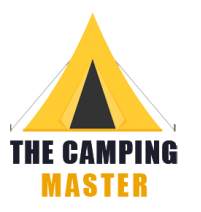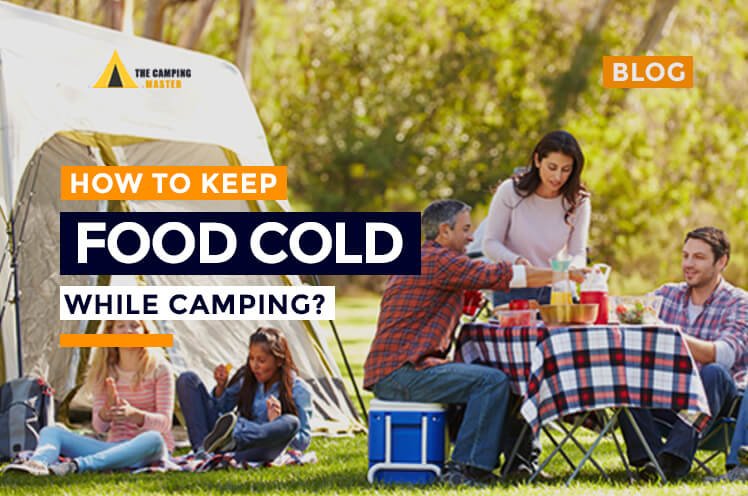How to keep food cold while camping? A camping trip with your family or friends is a great adventure and enjoyment. If you plan a camping trip, you may worry about many things, especially how to keep your food cold. Keeping your food safe and cold during outdoor camping is very important. You must eat your food while camping; therefore, keeping your food cold is important for survival.
20 Easy Ways to Keep Food Cold While Camping
Keeping your food cold is important while camping to prevent anyone from getting sick like poisoning. Here are some easy ways to keep your food cold while camping.
1. Buy a good quality cooler
It would be best if you bought a good quality cooler to keep your food cold at the campsite. A good quality cooler will keep your food cold because of its thicker walls and better insulation. On the other hand, a low-quality cooler cannot keep your food safe for a long time because of bad insulation.
A good quality cooler will provide enough space to store enough food for a couple of days and keep your food safe by keeping warm air outside and cold air inside the cooler.
Read More: Why Yeti Coolers Are So Expensive?
2. Electric coolers for tent camping
You can also buy electric coolers for tent camping. These coolers are mini-fridges and can run with your car battery. You can also use them as a warmer, depending upon their model. After buying this cooler, you don’t need to worry about ice blocks or ice packs to keep your food cold.
3. RV refrigerator
Most recreational vehicles RVs have electric or propane-powered freezers. These have a bad reputation for having hot and cold spots throughout the refrigerator due to a lack of airflow. It is a good idea to utilize a Fridge Aerator to stabilize the temperature inside the refrigerator.
Use a thermometer inside the cooler & fridges.
A thermometer inside a cooler or fridge is the best way to check their temperature.
4. Chill your coolers before going camping
It will be very helpful to chill your coolers before going for camping to keep food cold longer. Fill your cooler with ice to keep its interior cold for at least 10 to 12 hours before adding your food. Also, keep your cooler in a cold place. Remove ice and water from melted ice, dry the cooler’s interior, and keep your food in it.
Read More: How to Insulate a Tent for AC?
5. Packing of cold food
It is better to keep your food in the home refrigerator for 12 to 14 hours before going tent camping. This process will help you to keep your food cold for a long time. For this, you have to do your shopping in advance for a trip and place it in the refrigerator.
Read More: How to pack meat for camping?
6. Freezing your food before packing
Freezing your food before packing will help keep the temperature inside the cooler cold and keep other food cold. Before preparing the frozen food, ensure it has had enough time to defrost because you don’t have a microwave at the campsite to defrost the food quickly.
7. Using dry ice for frozen foods is great.
Using dry ice packs is the greatest technique to prevent frozen food from defrosting. However, be careful handling it because it is extremely cold (109.3 °F/78.5 °C), and touching it could cause you to burn or freeze any exposed skin. The advantage of dry ice is that it evaporates rather than melts because it is carbon dioxide in solid form. It implies that, unlike when you use ordinary ice cubes or blocks, you won’t have to worry about water puddles caused by melted ice.
8. Use ice packs
Use ice packs instead of putting an ice layer on top of food because the food will get soggy as ice melts. Therefore, it is important to put ice in a completely waterproof container. These ice packs keep your food cold for a long time and don’t create unnecessary water inside the cooler.
Read More: How Do Long Ice Packs Last?
9. Stored chilled water in the container
You can use frozen water bottles as a layer between the food rather than ice cubes. Frozen bottles are better than ice cubes because as the bottle defrosts, the water will not spread inside the cooler. You can later drink the water from these bottles. This process will keep your food dry,
safe and cold as well.
10. Use block ice
A larger block of ice melts slower than loose ice cubes. Large ice cubes will surely take up more space than you need for your food. So, you must keep the space for your food before using block ice.
11. Use waterproof bags to Guard your food against melting ice
You must protect your food from melting ice if you have decided to use ice inside the cooler to keep food cold. You can use waterproof bags like zip lock freezer bags to protect your food from melting ice.
12. Must know the places from where you can get more ice
It is not always possible to get enough ice for your entire trip because of a lack of space. So, you must know where you can get ice whenever you want. Look for the nearest gas station or
superstore for buying ice.
13. Opt right way of packing in your cooler
Some people pack their food in a method to keep the food they eat on the last day at the bottom and the first day at the top, but that’s the wrong method.
You must pack your food in a cooler the right way to keep your food safe. The best way is to pack raw food like meat at the bottom and less temperature-sensitive food like vegetables on the top. Packing your cooler the right way will keep your trip clean and safe.
14. Use multiple coolers
It would help if you used multiple coolers for camping to avoid spoiled meat and dairy products. You open the cooler for drinks more than the food. Keeping food items and drinks in a separate cooler is important. The cooler you open more often will warm much more quickly than the other one.
15. Keep coolers under shad
Place your cooler safe from direct sunlight. Please place them in the shade of a tree, car, or building. Make sure to change the position of the cooler as the shade shifts with the sunlight. Also, place your cooler on a cold surface like grass or a cold mat rather than a hot surface.
16. Make Extra insulation for your coolers.
To keep hot air outside the cooler and cold air inside it. You have to place an insulated cover on the sides and top of the cooler to keep the food inside the cooler.
17. Use the lid of your cooler quickly while opening & close
You have to be quick if you need anything from the cooler. You must know where everything is placed inside the cooler to get it out quickly. Keep the cooler’s lid closed as much as possible to prevent hot air from getting inside the cooler. The hot air outside is like an enemy for your food inside the cooler.
18. Keep it full
Don’t empty the cooler prematurely. When a cooler is empty, something usually warm air fills the vacant space. As you finish eating the food in your coolers, start combining the contents and work your way down, removing any coolers that aren’t full while keeping the remaining coolers fully stocked with ice or ice packs.
19. Cook at the campsite
When camping, it’s always a good idea to bring enough food to cook on the campfire. Cooking a whole batch of chili over a campfire will be fun and easy. Make it at home, and you won’t have to refrigerate any of the leftovers until camp. You can leave the tomato sauce, onions, garlic, beans in cans, and other ingredients unrefrigerated before opening or slicing.
20. Plan Non-Perishable food meals
You can lessen the space needed for cold food storage on your trips. Prefer eating cold, delicate foods while also packing non-perishable, non-refrigerated items. Meats that are not refrigerated are a fantastic way to consume meat without worrying about dangerous temperatures. Take summer sausages and beef jerky. Consider consuming protein from shelf-stable, non-refrigerated foods to ensure you have enough on your travels.
Food Safety Guidelines for Camping
Food safety while camping is important for your and your family’s health. Here are some guidelines;
1. Cleanliness
In a dirty outside environment, bacteria can spread quickly. Therefore, it is important to bring soap, clean towels, hand sanitizers, and water. Wash your food properly before eating, and wash your hands before and after eating.
Wash your dishes with soap properly and also use a garbage bag to throw trash in it. Don’t spread your trash around your tent.
2. Saving water
Don’t waste your drinking water washing hands or face. If you lack drinking water, you have to boil the wild water before drinking. Never drink directly from any lake or stream, no matter how clean it looks. You can fill your water bottle from a stream or lake and boil it before drinking to kill all the microorganisms in the water. If you can’t boil water, you can use water purification tablets, but read the manufacturer’s label carefully before using a tablet.
3. Keeping raw meat away from other food
Raw meat has bacteria that can easily spread to other foods in the cooler. You have to double-wrap the meat before packing it in a cooler. Always wash your hands before and after handling the meat to prevent the bacteria from spreading through your hands.
4. Separating hot and cold food
You have to keep food in their temperature range which varies from 40F to 140F. Make sure you store cold food in a cold place and hot food in a hot place. You can use a hot container to store hot food to keep it hot.
Final Thoughts
Keeping your food cold while camping is not difficult in this modern time. You can buy a good quality cooler to pack your food in it. You can also buy hot containers to keep your food hot. If you are going for a long trip, you can buy electric coolers that will run on your car battery.
Use a thermometer inside the cooler to check the temperature which will help you to make sure your food is at a safe temperature. To keep your cooler cold, fill it with ice before packing your food. Also, freeze your food in the home refrigerator before packing.
You can use ice packs in your cooler at a warm temperature for extra cooling. Never use ice without waterproof packing inside the cooler to prevent food from getting soggy. Using frozen water bottles in a cooler is also a good option. You can drink that water later after melting.
Never open your cooler for a long time to prevent heat from going inside the cooler. Pack your cooler properly and remember where everything is placed to get it out quickly. Using an extra cooler for drinks is always better because you open your cooler for drinks more than the food.
Always follow food safety guidelines while camping. Check your food properly before eating and smell it too. Clean your hands properly before and after touching food. Use hand sanitizer to prevent bacteria from one food from spreading to other foods.
You are responsible for keeping the campsite area clean during and after camping. Never throw your trash anywhere. Use trash bags to keep your trash in, and throw it in a dustbin to keep nature clean and safe.
Read More: How to make toast while camping?

